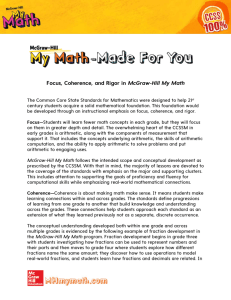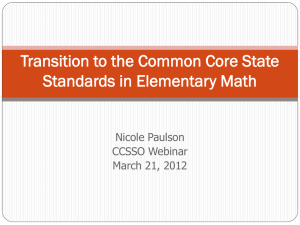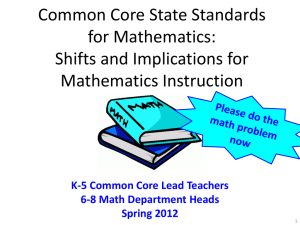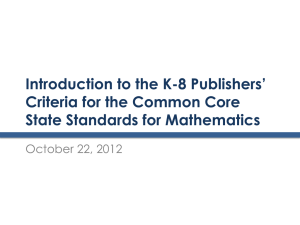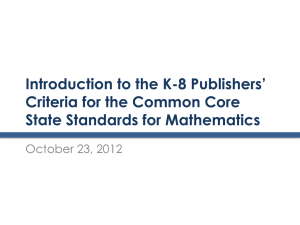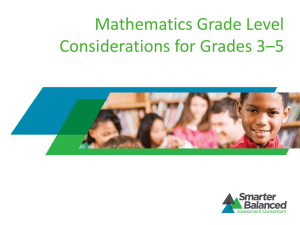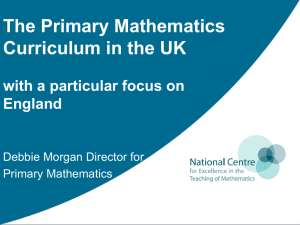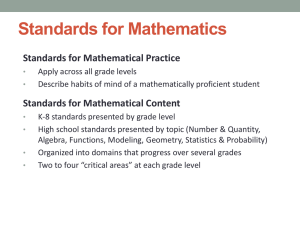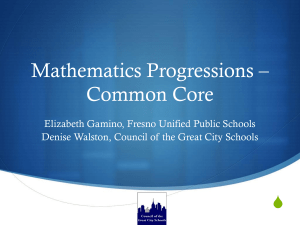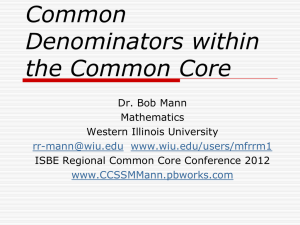Mathematics - New Mexico State Department of Education
advertisement
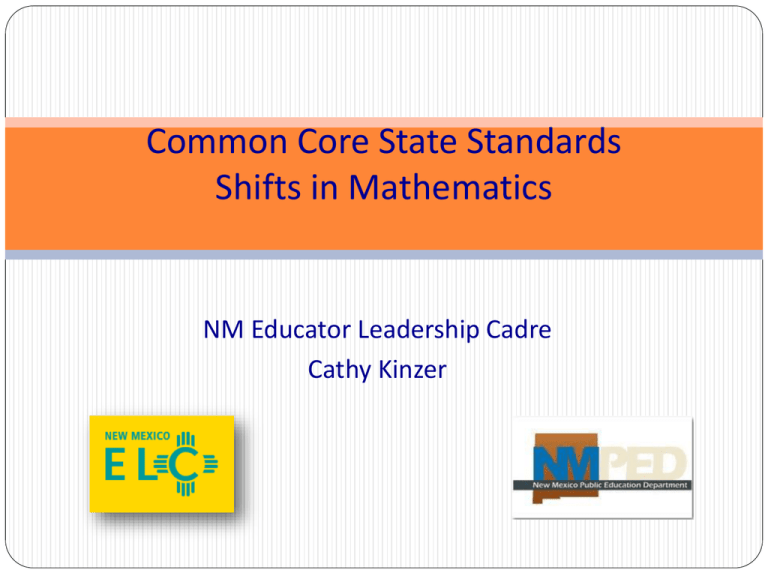
Common Core State Standards Shifts in Mathematics NM Educator Leadership Cadre Cathy Kinzer Research Connection: Dr. Bill Schmidt from Michigan State University surveyed teachers on implementation of CCSSM: • After reading sample CCSSM topics for their grade, ~80% say CCSSM is “pretty much the same” as their former standards • If CCSSM places a topic they currently teach in a different grade only about ¼ would drop it Definition of Insanity? Doing the same thing and expecting different results… The Background of the Common Core State Standards Initiated by the National Governors Association (NGA) and Council of Chief State School Officers (CCSSO) with the following design principles: • Result in College and Career Readiness • Based on solid research and practice evidence • Fewer, clearer and more rigorous 4 College Math Professors Feel HS students Today are Not Prepared for College Math 5 What The Disconnect Means for Students • Nationwide, many students in two-year and four-year colleges need remediation in math. • Remedial classes lower the odds of finishing the degree or program. • Need to set the agenda in high school math to prepare more students for postsecondary education and training. 6 Learning Goals for the Session What are the six shifts in mathematics required of CCSS? What are the implications for instruction, curriculum and assessment? What are the 6 Shifts in Mathematics? Focus Coherence Fluency Deep Understanding Applications Dual Intensity The Six Shifts in Mathematics: Represent key areas of emphasis as teachers and administrators implement the Common Core State Standards for Mathematics. Establishing a statewide focus in these areas can help schools and districts develop a common understanding of what is needed in mathematics instruction as they move forward with implementation Must be enacted in order to make changes to instruction and the opportunities students have to learn mathematics Shape the PARCC assessments Shift #1 Focus Focus strongly where the Standards Focus Teachers use the power of the eraser and significantly narrow and deepen the scope of how time and energy is spent in the math classroom. They do so in order to focus deeply on only the concepts that are emphasized in the standards so that students can engage in the mathematical practices, engage in rich discussions, reach strong foundational knowledge and deep conceptual understanding. Focus ensures students learn important math content completely rather than superficially. • Move away from "mile wide, inch deep" curricula identified in TIMSS. • • Learn from international comparisons. Teach less, learn more. “Less topic coverage can be associated with higher scores on those topics covered because students have more time to master the content that is taught.” – Ginsburg et al., 2005 11 The shape of math in A+ countries Mathematics topics intended at each grade by at least twothirds of A+ countries Mathematics topics intended at each grade by at least twothirds of 21 U.S. states 1 Schmidt, Houang, & Cogan, “A Coherent Curriculum: The Case of Mathematics.” (2002). 12 Traditional U.S. Approach K 12 Number and Operations Measurement and Geometry Algebra and Functions Statistics and Probability 13 CCSS Number and Operations Progression Operations and Algebraic Thinking Expressions → and Equations Number and Operations— Base Ten → K 1 2 3 4 Algebra The Number System Number and Operations— Fractions → → → 5 6 7 8 High School 14 Key Areas of Focus in Mathematics Grade Focus Areas in Support of Rich Instruction and Expectations of Fluency and Conceptual Understanding K–2 Addition and subtraction - concepts, skills, and problem solving and place value 3–5 Multiplication and division of whole numbers and fractions – concepts, skills, and problem solving 6 Ratios and proportional reasoning; early expressions and equations 7 Ratios and proportional reasoning; arithmetic of rational numbers 8 Formulating and reasoning about expressions and equations and informally exploring functions 15 Shift #2 Coherence Think Across Grades, and Link to Major Topics Within Grades • Carefully connect the learning within and across grades so that students can build new understanding on foundations built in previous years. • Begin to count on solid conceptual understanding of core content and build on it. Each standard is not a new event, but an extension of previous learning. 16 Coherence: Think Across Grades Example: Fractions “The coherence and sequential nature of mathematics dictate the foundational skills that are necessary for the learning of algebra. The most important foundational skill not presently developed appears to be proficiency with fractions (including decimals, percents, and negative fractions). The teaching of fractions must be acknowledged as critically important and improved before an increase in student achievement in algebra can be expected.” Final Report of the National Mathematics Advisory Panel (2008, p. 18) 17 CCSS Grade 4 Grade 5 4.NF.4. Apply and extend previous understandings of multiplication to multiply a fraction by a whole number. 5.NF.4. Apply and extend previous understandings of multiplication to multiply a fraction or whole number by a fraction. 5.NF.7. Apply and extend previous understandings of division to divide unit fractions by whole numbers and whole numbers by unit fractions. 6.NS. Apply and extend previous understandings of multiplication and division to divide fractions by fractions. Grade 6 Informing Grades 1-6 Mathematics Standards Development: What Can Be Learned from High-Performing Hong Kong, Singapore, and Korea? American Institutes for Research (2009, p. 13) 6.NS.1. Interpret and compute quotients of fractions, and solve word problems involving division of fractions by fractions, e.g., by using visual fraction models and equations to represent the problem. 18 Alignment in Context: Neighboring Grades and Progressions One of several staircases to algebra designed in the OA domain. 19 Coherence: Link to Major Topics Within Grades Example: Data Representation Standard 3.MD.3 20 Coherence: Link to Major Topics Within Grades Example: Geometric Measurement 3.MD.7 21 Shift #3 Fluency Fluency is not meant to come at the expense of understanding but is an outcome of a progression of learning and sufficient thoughtful practice. It is important to provide the conceptual building blocks that develop understanding in tandem with skills along the way to fluency. Fluency is developed through making sense of mathematical ideas over time and developing thinking strategies until they can become easily useful and applicable. Required Fluencies in K-6 Grade Standard Required Fluency K K.OA.5 Add/subtract within 5 1 1.OA.6 Add/subtract within 10 2 2.OA.2 2.NBT.5 Add/subtract within 20 (know single-digit sums from memory) Add/subtract within 100 3 3.OA.7 3.NBT.2 Multiply/divide within 100 (know single-digit products from memory) Add/subtract within 1000 4 4.NBT.4 Add/subtract within 1,000,000 5 5.NBT.5 Multi-digit multiplication 6 6.NS.2 6.NS.3 Multi-digit division Multi-digit decimal operations 23 Fluency in High School 24 Shift #4 Deep Understanding: A Solid Conceptual Understanding • Teach more than “how to get the answer” and instead support students’ ability to access concepts from a number of perspectives • Students are able to see math as more than a set of mnemonics or discrete procedures • Conceptual understanding supports the other aspects of rigor (fluency and application) 26 This example does not elicit conceptual understanding 27 This example provides a better opportunity to assess place value understanding. 28 Shift # 5 Applications • Students can use appropriate concepts and procedures for application even when not prompted to do so. • Teachers provide opportunities at all grade levels for students to apply math concepts in “real world” situations, recognizing this means different things in K-5, 6-8, and HS. • Teachers in content areas outside of math, particularly science, ensure that students are using grade-levelappropriate math to make meaning of and access science content. 29 Shift #6 Dual Intensity Students are making sense of mathematics through practicing and understanding. There is more than a balance between these two things in the classroom – both are occurring with intensity. Teachers create opportunities for students to participate in application of procedural and conceptual knowledge through extended application of math concepts. The amount of time and energy spent practicing and understanding learning environments is driven by the specific mathematical concept and therefore, varies throughout the given school year. Pause: Any Questions? What are the implications for instruction, curriculum and assessment? Implications for Instruction, Curriculum and Assessment The 6 shifts describe the changes needed in instruction and students’ opportunities to learn math. The Six Math Shifts and the Mathematical Practice Standards describe what classroom instruction and student learning should look like and sound like. The PARCC Model Content Framework utilizes shifts PARCC Model Content Frameworks Content Emphases by Cluster: Grade Four Key: Major Clusters; Clusters Supporting Clusters; Additional 34 Implications for Curriculum, Instruction and Assessment Content Emphases by Cluster Not all of the content in a given grade is emphasized equally in the standards. Some clusters require greater emphasis than the others based on the depth of the ideas, the time that they take to master, and/or their importance to future mathematics or the demands of college and career readiness. In addition, an intense focus on the most critical material at each grade allows depth in learning, which is carried out through the Standards for Mathematical Practice. To say that some things have greater emphasis is not to say that anything in the standards can safely be neglected in instruction. Neglecting material will leave gaps in student skill and understanding and may leave students unprepared for the challenges of a later grade. Curriculum, Instruction and Assessment Rigor of daily math tasks (must include high cognitive demand engaging tasks) Standards for Mathematical Practice- Critical thinking reasoning and communication Depth of knowledge- Knowledge packets- understanding mathematical concepts deeply applying them within and across standards and content The classroom should look and sound like the students and teacher are engaging in the Standards for Mathematical Practices Instructional resources should afford opportunities to make sense of mathematics and develop math ideas over time through the Standards for Mathematical Practices Students will be assessed on the CCSSM: The Cluster (including headings and numbered statements) and Standards for Math Practice Curriculum Instruction and Assessment • The current U.S. curriculum is often "a mile wide and an inch deep." • Focus is necessary in order to achieve the rigor set forth in the CCSS. • As we saw in the curriculum from other countries, a deep understanding of fewer mathematical concepts pays off. • Instruction must be grounded in CCSSM and the PARCC Model Content Frameworks which includes the Standards for Mathematical Practices 37 Implications for Curriculum, Instruction and Assessment Curriculum resources vetted by PED forthcoming Publishers Criteria for considering curriculum resources: http://www.corestandards.org/assets/Math_Publishers _Criteria_K-8_Summer%202012_FINAL.pdf Item prototypes parcconline.org Resources Used for This Presentation http://newmexicocommoncore.org/pages/view/86/co mmon-core-state-standards-shifts-in-mathematics/9/ http://newmexicocommoncore.org/mathematics/ http://www.corestandards.org/thestandards/mathematics www.ped.state.nm.us/ www.achievethecore.org www.illustrativemathematics.org http://parcconline.org/parcc-content-frameworks http://vimeo.com/30924981
